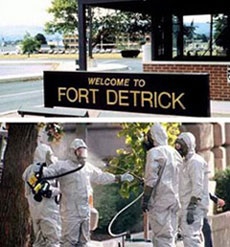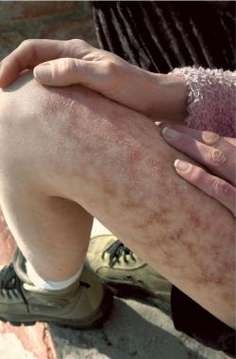By Hank P. Albarelli Jr.*, Zoe Martell*
18 May 2010
From
Miami (United States)
Last week’s Voltaire Network article concerning the mysterious spread of a fungus disease in the Northwest United States provoked a number of readers to contact Mr. H. P. Albarelli Jr., the author of both these articles, with new information concerning strange diseases and the U.S. Army’s covert biological warfare activities which involve the use of chemical and biological weapons against human beings. There is a history of U.S. secret human experimentation. In this case, it is unsuspecting U.S. citizens who are the victims.
.
I went to put some of the medicated salve on the lesions on my face and when I put the salve near them, the filaments beneath my skin moved into a group and then moved away from the area I was going to treat. I was dumbstruck. I didn’t know what to think. I screamed for my husband to come … the damn things beneath my skin were alive; they moved to avoid treatment.
Morgellons victim, Vermont, May 2010.
One reader, former military scientist, Dr. Hanley Watson, revealed that the Army, “from 1950 to at least mid-1976” conducted “numerous experiments simulating biological or germ warfare attacks in dozens of locations across the country.” Said Watson, “Previously these experiments were downplayed by the Pentagon as ‘harmless tests’ occurring in about 8 areas in the US and employing benign substances, but this couldn't be further from the truth.”
Watson was referring to a 1976 Pentagon press conference during which an Army spokesman revealed that researchers with the Army’s Fort Detrick and Edgewood Arsenal, both in Maryland, conducted “simulated germ warfare attacks, using nondisease [sic] causing biological substances in 8 areas of the US.” Among these experiments were a 1950 operation off the coast of San Francisco; a 1966 biological warfare experiment in Manhattan in which “the vulnerability of the New York subway system was tested;” and at least three experiments conducted in Pennsylvania, Fort McClellan, Alabama, and California with “fungal substances” to “perform field evaluations to determine vulnerability to enemy biological attack.”
As widely reported in the mid-1970s, the San Francisco experiment resulted in the death of at least one person. Additionally, the 1952 Alabama experiments resulted in a doubling of pneumonia cases in the surrounding areas. Nonetheless, Army officials stated, “There is nothing we have that shows any links between these tests and any outbreak of infection or any deaths.”
Army officials went on in defending themselves and the experiments by stating that the substance the Army used in many of the experiments was Serratia marcescens, which they maintained is harmless. Said the Pentagon, “The substance is present throughout the environment and is considered not to cause disease.” But other physicians said this claim is simply wrong. Several responsible physicians pointed out that Serratia marcescens does cause infection in humans; and is commonly found in bathrooms and public rest rooms. Doctors also state that some strains of the bacterium are resistant to multiple antibiotics.
Eventually in 1976, the Pentagon amended its position, stating: “For some individuals who lack a capability to develop immunity to most disease, Serratia marcescens could conceivably act as an opportunist and produce an infection.” Assumably, the Pentagon was not referring to AIDS patients, however, it is interesting to note that 1976 was about 6 years into its research on a disease that sounded remarkably like AIDS. Also, apparently the Pentagon was unaware of a 1946 Fort Detrick medical journal paper by Dr. Tom F. Paine, which detailed an Army experiment with Serratia marcescens that resulted in illness and infection in 4 subjects exposed to the bacterium delivered in aerosol form.
Explained Watson further, “The experiments conducted from the early 1950s through 1976 were many more in number than officially stated, and they were conducted in many more locations than the reported eight.” Added Watson, “In the 1950s and 1960s alone there were easily about two dozen experiments conducted in the New England area.” One of the larger experiments, as detailed in my book, A Terrible Mistake: The Murder of Frank Olson and the CIA’s Secret Cold War Experiments [1], is the strange, and allegedly coincidental, experiment at a Manchester, New Hampshire woolen mill that resulted in the anthrax-related tragic deaths of 4 mill employees. In September 1957, at the same time the outbreak took place, biochemists from Fort Detrick just happened to be on site at the mill performing tests with an anthrax vaccine. Fort Detrick researcher Dr. George G. Wright had developed the prototype vaccine being tested at the mill. Wright’s vaccine is essentially the same controversial serum administered today to American troops.
Watson also cited a number of Army experiments conducted during the same time period and later with spore-borne diseases. One of these experiments was conducted in Mechanicsburg, Pennsylvania. There the Army used a fungal substance known as aspergillus fumigatus. Watson said that this fungal substance could result in disease and severe infection in humans. In addition to the aspergillus fungus, Watson and a former Fort Detrick microbiologist said the Army, through the Special Operation Division (SO) at Fort Detrick, experimented with several other fungus substances including spore-borne C. gattii from Australia, and with a “substance very much like Morgellons disease in its effects.”
This substance was referred to as “FD-CPX.” Said the former Detrick scientist, who worked under project MK/NAOMI, a joint CIA-Army program for 6 years, “CPX was a problematic substance for us. We worked with it in mutated form, and a number of sub-contractors came down with the disease and that caused all sorts of additional problems. They were still working with it when I left the post. I don’t know if SO ever got it right.”
The Mechanicsburg experiment took place, according to Pentagon officials, “in a warehouse in the area” that “was completely closed off to others not participating in the tests.” Said an Army spokesman, “The fungus was not released into the atmosphere outside the warehouse and presented no dangers to anyone unrelated to the activity.”
In light of future developments in Mechanicsburg, following the experiment, this assertion is difficult to accept. Several years after the Army activities, scientists in Pennsylvania began to notice that an unusually large number of animals, including cats, dogs, and horses that had become ill from the fungus infection. Reportedly, the number of animals that became ill increased for a number of years.
Dr. Watson, along with two other former Fort Detrick researchers, including the late Dr. Henry Eigelsbach, also revealed an odd experiment that took place in Pascagoula, Mississippi and produced one of the most puzzling UFO and strange entity cases on record in America. This was the incident, detailed in Albarelli’s book, involving two local fishermen who claimed to have been abducted by aliens from a fishing pier in October 1973. Much overlooked in the case is that the pier was not far away from a former Fort Detrick research site, Horn Island. The barrier island was formally used from 1943 to 1945 by Army researchers, but former microbiologists with the military report that several experiments were conducted on the island, and other islands off the coast of Maryland, in the late 1960s and early 1970s. Detrick microbiologists conducted intensive experiments on the islands “involving human research subjects” and a number “of natural hallucinogenics as well as advanced neuroscience techniques” aimed at the objection of producing “previously unexplored and unique psychological warfare methods.” Some researchers maintain that these experiments were part of the Army’s top-secret Operation Strange Man, which is said to have involved “mutated human subjects.” As unbelievable as these reports seem, there have been unexplained sightings, some by law enforcement officials, of very odd humanoid creatures in several of the related locations over the years. Said one of Watson’s former Detrick colleagues: “These were experiments involving human subjects that went way beyond what anyone could imagine. Some of the findings and technology was transferred to Southeast Asia during the later stages of the war there.”
Besides Horn Island, the Army’s Chemical Corps and Fort Detrick conducted numerous experiments at Plum Island off the coast of New York. In the early 1950s, Plum Island, originally known as Fort Terry, was under the command of the Army Chemical Corps, and then in 1954 it was nominally transferred to the jurisdiction of the U.S. Department of Agriculture, and the mission of its research was changed from “one which encompassed studies on various exotic animal diseases to determine both their offensive and defensive potentialities as biological warfare agents to one which pertains only to the defensive aspects of [animal diseases],” according to writer Michael Carroll, who wrote a book on Plum Island. Despite the changes made to the official record, research at Plum Island changed little in reality; diseases with the potential to be used as offensive agents continued, unhindered, and a close relationship remained in place between Plum Island and the Department of Defense.
Lyme disease is a tick-vectored spirochetal disease, which was identified in 1975 when a mysterious illness broke out among residents in Old Lyme, Connecticut. It rarely appears by itself in humans, with sufferers often testing positive for infection by several tick-borne diseases concurrently. The Plum Island animal diseases laboratory is located a mere twelve miles from the first identified cases of Lyme disease.
Research at the Plum Island facility is known to have included diseases carried by arthropods; in fact, Carroll describes in his book the historical presence of a large “tick colony” on the premises. Carroll’s history of the testing done at the facility indicates that outdoor, field testing of diseases was done on and near Plum Island, and also details numerous breaches in safety procedures throughout the history of the laboratory’s operation. In 1978, for example, a cattle disease called Hoof and Mouth disease escaped from the Plum Island, infecting cattle in neighboring areas.
According to declassified army documents, Fort Derick scientists also experimented widely with Venezuelan Equine Encephalomyelitis Virus (VEEV). Several documents cite that Fort Detrick assigned some of its top researchers to efforts to weaponize the virus, but say nothing about the number of former Nazi biochemists who worked closely with Fort Detrick and Edgewood Arsenal researchers, including the much overlooked German scientist, Dr. Gernot Bergold.
.
Gernot H. Bergold (1911–2003)
The U.S. Army’s Project Paperclip [2] secretly brought Bergold to the United States after the war. In America, Dr. Bergold, who under Hitler’s Third Reich headed the Nazi’s Entomological Department and the Department of Insect Vectors of the Division of Virus Research, secretly worked on the VEE virus for the military at Fort Detrick, and then at a military-sponsored facility in Sault Ste. Marie, Michigan. Psychologist Dr. Karen Cronick, who now works in Venezuela, reports that in the 1970s, at about the same time Bergold was conducting his work with VEE, there was an outbreak of the virus in Michigan. This outbreak has been virtually blacked out by the media and state officials.
Dr. Cronick states, “The coincidence of these events has always troubled me. A tropical disease that was researched in Michigan suddenly appeared there in the general population. There is no way the insect vector that transmits the disease could get so far north by any normal migration. Could the Michigan outbreak have been a controlled experiment? It is the perfect place to carry one out: the Great Lakes and winter are natural limits to any unrestrained expansion of infected vectors.”
As reported in an earlier Voltaire Network [3] by this author, Morgellons disease, which was experimented with by Fort Detrick in the 1960s and beyond, has recently been reported as a “disease of high-level concern” in certain areas of the country, including Vermont, and Florida, Texas, and California. For reasons thus far unknown, Morgellons seems to be wide spread among Vermont’s small population of 600,000. Some doctors in Chittenden County, Vermont’s most populated region estimate that about 300 people in the state have the disease.
According to a number of organizations dedicated to the study of Morgellons, there are about 15,000 people in the US suffering from the disease. Included in this number are many well-known names, singer Joni Mitchell, baseball player Billy Koch, and others.
Natasha Cebek, 44, who lives in Vermont with her 3 children, reported that she has had Morgellons disease for about 3 years. “I don’t really know how I contracted the disease,” she said in an interview this week. “I came to Vermont years ago to live in a clean, natural environment free from pollution and environmental assaults and never imagined anything like this would happen to me.”
Cebek says she has been to several physicians nearly all of whom “gave me a Stepford wives-type smile. One even offered to send me to a psychotherapist. That made me quite angry; I had been healthy all my life; I had taken special care to eat properly and live a quality life and to teach my children to do the same. I didn’t need psychological attention; I needed medical care; quality, expert care.”
Cebek states, “There’s no comfort in numbers. I’ve learned that well over a hundred people have sought treatment for this disease at the same facilities I’ve visited. That’s a major outbreak in my view; that’s a major public health problem, but health officials here don’t speak about it publicly.”

One form of Mogellons disease.
Kathleen Vanoudenallen, a registered nurse who is a close friend of Cebek’s, and who has intensively studied Morgellons for years, and first diagnosed Cebek, stated this week, “I don’t think there’s much doubt that Morgellons looks like something that has been altered, something not natural that may have been created in a lab, something weaponized. Some former military researchers say they worked on just such a disease years ago. How it got out into the general population is anyone’s guess. Nobody wants to go on the record with information about the government’s work with the disease.”
Recounted Cebek, “When I learned that this disease could possibly be a result of covert biological warfare work performed by our government I was outraged. I wanted to scream, to smash the wall. How dare they do this to unsuspecting citizens? How dare they use people like this? What gives them the right? Who the hell do they think they are?”
http://www.voltairenet.org/article165450.html#article165450
Hank P. Albarelli Jr.
Investigative journalist and writer who lives in Florida and Vermont. Last book published : "A Terrible Mistake: The murder of Frank Olson and the CIA’s secret Cold War Experiments." Albarelli’s book documents and details numerous CIA and Pentagon sponsored experiments on unwitting human subjects. Albarelli is a founding member of the recently formed North American Truth and Accountability Commission on Human Experimentation.
Zoe Martell
Lecturer in psychology at San Francisco State University; much of her work has focused on the experiences of people suffering from chronic illnesses. She is also an artist, and is currently working toward a dual master’s degree at San Francisco Art Institute.